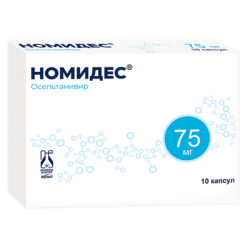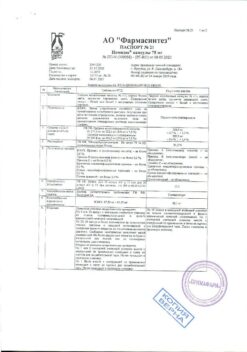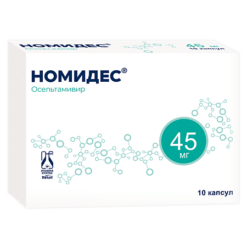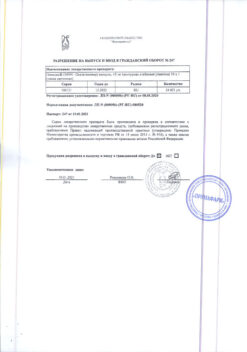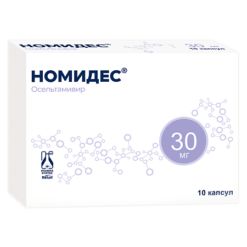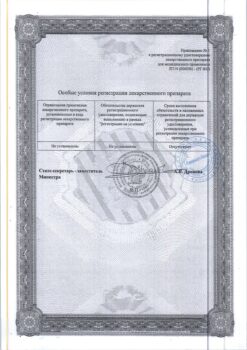No products in the cart.
Description
Antiviral drug. Oseltamivir is a prodrug, its active metabolite (oseltamivir carboxylate, OC) is an effective and selective inhibitor of influenza virus neuraminidase type A and B – the enzyme that catalyzes the release of newly formed viral particles from infected cells, their penetration into uninfected respiratory epithelial cells and further spread of the virus in the body. Inhibits the growth of influenza virus in vitro and suppresses viral replication and pathogenicity in vivo, reduces the release of influenza A and B viruses from the body. The OC concentration required to inhibit neuraminidase by 50% (IC50) is 0.1-1.3 nM for influenza A virus and 2.6 nM for influenza B virus. The median IC50 value for influenza B virus is slightly higher at 8.5 nM.
Clinical efficacy
In the studies conducted, oseltamivir had no effect on influenza antibody formation, including antibody production in response to administration of inactivated influenza vaccine.
Studies of natural influenza infection
In clinical studies conducted during seasonal influenza infection, patients were started on oseltamivir no later than 40 h after the first symptoms of influenza infection appeared. 97% of patients were infected with influenza A virus and 3% of patients were infected with influenza B virus. Oseltamivir significantly shortened the period of clinical manifestations of influenza infection (by 32 hours). In patients with a confirmed diagnosis of influenza who took oseltamivir, the severity of the disease, expressed as the area under the curve for the total index of symptoms, was 38% lower compared to patients who received placebo. Moreover, in young patients without comorbidities, oseltamivir reduced by about 50% the incidence of flu complications requiring antibiotics (bronchitis, pneumonia, sinusitis, otitis media). There was clear evidence of efficacy of the drug with respect to secondary efficacy criteria relating to antiviral activity: oseltamivir caused both a shortening of the time of virus release from the body and a reduction in the area under the “viral titers-time” curve.
The data from a study of oseltamivir therapy in elderly and elderly patients show that administration of oseltamivir at a dose of 75 mg twice daily for 5 days was accompanied by a clinically significant reduction in the median period of clinical manifestations of influenza infection, similar to that in younger adult patients, but the differences did not reach statistical significance. In another study, patients over 13 years of age with influenza who had concomitant chronic cardiovascular and/or respiratory diseases received oseltamivir in the same dosing regimen or placebo. There were no differences in the median period before reduction of clinical manifestations of influenza infection in the oseltamivir and placebo groups, but the period of fever with oseltamivir was shorter by about 1 day. The proportion of patients who excreted the virus on days 2 and 4 became significantly less. The safety profile of oseltamivir in at-risk patients did not differ from that in the general population of adult patients.
Treatment of influenza in children
A double-blind, placebo-controlled study was conducted in children aged 1-12 years (mean age 5.3 years) who had fever (≥37.8°C) and one of the respiratory system symptoms (cough or rhinitis) during the period of influenza virus circulation in the population. Sixty-seven percent of patients were infected with influenza A virus and 33% of patients were infected with influenza B virus. Oseltamivir (when taken no later than 48 h after the onset of the first flu infection symptoms) significantly reduced the duration of illness (by 35.8 h) compared to placebo. The duration of the disease was defined as the time until the cough, nasal congestion, disappearance of fever, and return to normal activity. The incidence of acute otitis media was reduced by 40% in the children treated with oseltamivir compared to the placebo group. Recovery and return to normal activity occurred almost 2 days earlier in children who received oseltamivir compared to the placebo group.
Another study involved children aged 6-12 years with bronchial asthma; 53.6% of patients had influenza infection confirmed serologically and/or in culture. The median duration of illness in the group of patients receiving oseltamivir did not decrease significantly. But by the last 6 days of therapy with oseltamivir, forced expiratory volume in 1 second (FEF1) increased by 10.8% compared with 4.7% in patients receiving placebo (p = 0.0148).
The prevention of influenza in adults and adolescents
The preventive efficacy of oseltamivir in natural influenza A and B infection has been proven in 3 separate phase III clinical trials. About 1% of patients became ill with influenza while taking oseltamivir. Oseltamivir also significantly reduced the frequency of virus excretion and prevented transmission from one family member to another.
Adults and adolescents who were in contact with a sick family member started taking oseltamivir within two days of the family member’s flu symptoms and continued it for 7 days, which significantly reduced the incidence of flu in contactees by 92%.
In unvaccinated and generally healthy adults aged 18-65 years, taking oseltamivir during an influenza epidemic significantly reduced the incidence of influenza (by 76%). Patients took the drug for 42 days.
In elderly and seniors in nursing homes, 80% of whom were vaccinated before the season when the study was conducted, oseltamivir significantly reduced the incidence of influenza by 92%. In the same study oseltamivir significantly (86%) reduced the incidence of flu complications: bronchitis, pneumonia, sinusitis. Patients took the drug for 42 days.
Preventing influenza in children
The preventive efficacy of oseltamivir in natural influenza infection has been demonstrated in children from 1 to 12 years after contact with a sick family member or someone in the regular environment. The primary efficacy parameter was the frequency of laboratory-confirmed influenza infection. In children who received oseltamivir in oral suspension powder form at a dose of 30 to 75 mg once daily for 10 days and who did not excrete the virus at baseline, the incidence of laboratory-confirmed influenza decreased to 4% (2/47) compared with 21% (15/70) in the placebo group.
Influenza prevention in immunocompromised persons
Prevention of influenza in immunocompromised persons
. In immunocompromised individuals with seasonal influenza infection and no viral release at baseline, prophylactic use of oseltamivir resulted in a reduction in the incidence of laboratory-confirmed influenza infection with clinical symptoms to 0.4% (1/232) compared with 3% (7/231) in the placebo group. Laboratory-confirmed influenza infection accompanied by clinical symptoms was diagnosed in the presence of oral fever above 37.2 °C, cough and/or acute rhinitis (all reported on the same day while taking the drug/placebo), and a positive reverse-transcriptase polymerase chain reaction for influenza virus RNA.
Resistance
Clinical studies
In all OK-resistant carrier patients, carriage was temporary, had no effect on virus elimination, and did not cause worsening of clinical condition.
Patient population | Patients with resistance mutations | ||
Phenotyping* | Phenotyping* | ||
Adults and adolescents | 4/1245 (0.32%) | 5/1245 (0.4%) | |
Children (ages 1-12) | | 25/464 (5.4%) | |
* Complete genotyping was not performed in any of the studies.
Post-exposure prophylaxis (7 days), family contact prophylaxis (10 days), and seasonal prophylaxis (42 days) in individuals with normal immune system function showed no cases of resistance to the drug when oseltamivir was administered. In the 12-week seasonal prophylaxis study in immunocompromised individuals, there were also no cases of resistance.
Data from individual clinical cases and observational studies
In patients not receiving oseltamivir, naturally occurring mutations of influenza A and B viruses that had reduced sensitivity to oseltamivir were found. In 2008, the H275Y substitution type mutation leading to resistance was found in more than 99% of the 2008 H1N1 virus strains circulating in Europe. The 2009 H1N1 influenza virus (“swine flu”) was sensitive to oseltamivir in most cases. Oseltamivir-resistant strains were found in individuals with normal immune system function and immunocompromised individuals taking oseltamivir. The degree of desensitization to oseltamivir and the frequency of such viruses may vary by season and region. Resistance to oseltamivir was found in patients with pandemic H1N1 influenza who received the drug for both treatment and prevention.
The incidence of resistance may be higher in younger patients and immunocompromised patients. Oseltamivir-resistant laboratory strains of influenza viruses and influenza viruses from patients treated with oseltamivir carry N1 and N2 neuraminidase mutations. Mutations leading to resistance are often specific to the neuraminidase subtype. When deciding whether to use oseltamivir, the seasonal sensitivity of the influenza virus to the drug should be considered (the latest information can be found on the WHO website).
Preclinical data
Preclinical data based on standard pharmacological safety, genotoxicity and chronic toxicity studies have not shown any particular risk to humans.
Carcinogenicity: The results of 3 studies of carcinogenic potential (two 2-year studies in rats and mice for oseltamivir and one 6-month study in Tg:AC transgenic mice for the active metabolite) were negative.
Mutagenicity: Standard genotoxic tests for oseltamivir and the active metabolite were negative.
Impact on fertility: oseltamivir at a dose of 1500 mg/kg/day had no effect on the generative function of male and female rats.
Teratogeneity: In studies examining the teratogenicity of oseltamivir at doses up to 1500 mg/kg/day (in rats) and up to 500 mg/kg/day (in rabbits) no effect on embryo-fetal development was found. In studies of antenatal and postnatal development in rats, when oseltamivir was administered at a dose of 1500 mg/kg/day, an increase in the period of labor was observed: the safety limit between human exposure and the maximum no-effect dose in rats (500 mg/kg/day) was 480 times higher for oseltamivir, and 44 times higher for its active metabolite. Exposure in the fetus was 15-20% of that in the mother.
Other: oseltamivir and its active metabolite penetrate the milk of lactating rats. Limited data indicate that oseltamivir and its active metabolite penetrate into human breast milk. Based on extrapolation of data from animal studies, their amounts in breast milk may be 0.01 mg/day and 0.3 mg/day, respectively.
In approximately 50% of the guinea pigs tested, skin sensitization in the form of erythema was observed when maximum doses of the active substance oseltamivir were administered. Reversible eye irritation in rabbits was also observed.
While very high oral single doses (657 mg/kg and above) of oseltamivir had no effect on adult rats, these doses had toxic effects on immature 7-day-old rat pups, including death of the animals. No undesirable effects were observed when chronically administered at a dose of 500 mg/kg/day from days 7 to 21 of the postnatal period.
Indications
Indications
Treatment of influenza in adults and children over the age of 1 year.
Prevention of influenza in adults and adolescents over 12 years of age who are in groups at high risk of contracting the virus (in military units and large industrial teams, in weakened patients).
Influenza prevention in children over 1 year old.
Active ingredient
Active ingredient
Composition
Composition
1 capsule 75 mg contains:
The active substance: oseltamivir phosphate – 98.5 mg (in terms of oseltamivir – 30.0 mg).
Auxiliary substances: pregelatinized corn starch, povidone K30, croscarmellose sodium, talc, sodium stearyl fumarate.
Solid gelatin capsule â 1: titanium dioxide, gelatin.
How to take, the dosage
How to take, the dosage
Treatment
The drug should be started within 2 days of the development of symptoms.
Adults and adolescents aged â¥12 years
Take 75 mg (one 75 mg capsule or one 30 mg capsule + one 45 mg capsule) 2 times daily orally for 5 days. Increasing the dose more than 150 mg/day does not increase the effect.
Children with a body weight of >40 kg or ages 8 to 12 years
Children who are able to swallow capsules may also be treated by taking one 75 mg capsule or one 30 mg capsule + one 45 mg capsule 2 times daily for
5 days.
Children 1 to 8 years of age
The recommended dosing regimen for oseltamivir capsules of 30 mg and 45 mg:
Body weight
Recommended dose over 5 days
⤠15 kg
> 15-23 kg
> 23-40 kg
> 40 kg
30 mg twice a day
45 mg twice a day
60 mg twice a day
75 mg twice daily
Extemporally prepared suspension can be used (see “Extemporally prepared suspension”).
It is possible to use a suspension prepared extemporaneously (see subsection “Extemporaneous preparation of oseltamivir suspension”).
Prevention
The drug should be started at least 2 days after exposure.
Adults and adolescents aged â¥12 years
Take 75 mg (one 75 mg capsule or one 30 mg capsule + one 45 mg capsule) once daily orally for at least 10 days after exposure. During seasonal influenza epidemics, 75 mg once daily for 6 weeks. The prophylactic effect lasts as long as the drug intake lasts.
Children with a body weight of >40 kg or ages 8 to 12 years
Children who can swallow capsules may also receive preventive therapy by taking one 75 mg capsule or one 30 mg capsule + one 45 mg capsule
once daily for 10 days.
Children 1 to 8 years of age
The recommended dosing regimen for oseltamivir is 30 mg and 45 mg capsules:
Body weight
Recommended dose over 5 days
⤠15 kg
> 15-23 kg
> 23-40 kg
> 40 kg
30 mg twice a day
45 mg twice a day
60 mg twice a day
75 mg twice daily
Extemporally prepared suspension can be used (see “Extemporally prepared suspension”).
It is possible to use a suspension prepared extemporaneously (see subsection “Extemporaneous preparation of oseltamivir suspension”).
Dosage in special cases
Patients with impaired renal function
Treatment
Patients with a creatinine clearance greater than 60 mL/min do not require dose adjustments. In patients with a creatinine clearance of 30 to 60 mL/min, the dose of oseltamivir should be reduced to 30 mg twice daily for 5 days.
In patients with a creatinine clearance of 10 to 30 mL/min, the dose of oseltamivir should be reduced to 30 mg once daily for 5 days. In patients on permanent hemodialysis, oseltamivir at the initial dose of 30 mg can be taken before dialysis if flu symptoms appear within 48 h between dialysis sessions. To maintain plasma concentrations at therapeutic levels, oseltamivir should be taken 30 mg after each dialysis session. In patients on peritoneal dialysis, oseltamivir should be taken at an initial dose of 30 mg before dialysis, then 30 mg every 5 days. Pharmacokinetics of oseltamivir in patients with end-stage renal failure (with creatinine clearance ⤠10 ml/min) who are not on dialysis have not been studied. In this regard, there are no dosing recommendations in this group of patients.
Patients with creatinine clearance greater than 60 mL/min do not require dose adjustment. In patients with a creatinine clearance of 30 to 60 mL/min, the dose of oseltamivir should be reduced to 30 mg once daily.
In patients with a creatinine clearance of 10 to 30 mL/min, it is recommended that the dose of oseltamivir be reduced to 30 mg once daily. In patients on permanent hemodialysis, oseltamivir at the initial dose of 30 mg can be taken before the start of dialysis (“1st session”). To maintain plasma concentrations at therapeutic levels, oseltamivir should be taken 30 mg after each subsequent odd-numbered dialysis session. In patients on peritoneal dialysis, oseltamivir should be taken at an initial dose of 30 mg before dialysis, then 30 mg every 7 days. Pharmacokinetics of oseltamivir in patients with end-stage renal failure (with creatinine clearance ⤠10 ml/min) who are not on dialysis have not been studied. In this regard, there are no dosing recommendations in this group of patients.
Patients with liver dysfunction
Dose adjustment is not required during treatment and prophylaxis of influenza in patients with mild to moderate liver dysfunction. Safety and pharmacokinetics of oseltamivir in patients with severe hepatic impairment have not been studied.
Elderly and elderly patients
Dose adjustment for prophylaxis or treatment of influenza is not required.
Patients with compromised immunity (after transplantation)
For seasonal flu prophylaxis in immunocompromised patients aged
⥠1 year – for 12 weeks, no dose adjustment is necessary.
Children
Oseltamivir in this dosage form should not be administered to children under 1 year of age.
Interaction
Interaction
Clinically significant drug interactions are unlikely according to pharmacological and pharmacokinetic studies.
Oseltamivir is extensively converted to the active metabolite under the action of esterases mainly located in the liver. Drug interactions caused by competition for binding to active esterase centers are not widely reported in the literature. The low degree of binding of oseltamivir and the active metabolite with plasma proteins gives no grounds to assume the presence of interactions connected with displacement of drugs from binding to proteins.
In vitro studies show that neither oseltamivir nor its active metabolite is a preferred substrate for polyfunctional cytochrome P450 oxidases or for glucuronyltransferases (see subsection “Pharmacokinetics”). There is no reason for interaction with oral contraceptives.
Cimetidine, a nonspecific inhibitor of cytochrome P450 system isoenzymes and competes with alkaline and cationic drugs during tubular secretion, does not affect plasma concentrations of oseltamivir and its active metabolite. Clinically significant interdrug interactions related to competition for tubular secretion are unlikely, given the safety margin for most such drugs, the excretion pathways of the active metabolite of oseltamivir (glomerular filtration and anionic tubular secretion), and the excretion capacity of each pathway.
Probenecid results in an AUC increase of the active metabolite of oseltamivir by approximately 2-fold (due to reduced active renal tubular secretion). However, no dose adjustment is required when concomitant use with probenecid, given the safety margin of the active metabolite.
Concomitant administration with amoxicillin does not affect plasma concentrations of oseltamivir and its components, showing little competition for excretion by anionic tubular secretion.
Concomitant administration with paracetamol has no effect on plasma concentrations of oseltamivir and its active metabolite or paracetamol.
Pharmacokinetic interactions between oseltamivir, its main metabolite were not found when concomitantly taken with paracetamol, acetylsalicylic acid, cimetidine, antacids (magnesium and aluminum hydroxide, calcium carbonate), warfarin, rimantadine or amantadine.
. When using oseltamivir with commonly used drugs such as ACE inhibitors (enalapril, captopril), thiazide diuretics (bendroflumethiazide), antibiotics (penicillin, cephalosporins, azithromycin, erythromycin and doxycycline), H2-histamine receptor blockers (ranitidine, cimetidine) Beta-adrenoblockers (propranolol), xanthines (theophylline), sympathomimetics (pseudoephedrine), opiates (codeine), glucocorticosteroids, inhaled bronchodilators and non-narcotic analgesics (acetylsalicylic acid, ibuprofen and paracetamol), no changes in the nature or frequency of adverse events were observed.
The use of oseltamivir in combination with drugs with a narrow therapeutic scope (e.g., chlorpropamide, methotrexate, butadione) should be used with caution.
Special Instructions
Special Instructions
Psychiatric disorders
Psychiatric disorders, seizures and delirium-like neuropsychiatric disorders have been reported in patients (mostly children and adolescents) who have taken oseltamivir to treat influenza. These cases were rarely accompanied by life-threatening actions. The role of oseltamivir in the development of these phenomena is unknown. Similar neuropsychiatric disorders have also been reported in influenza patients who did not receive oseltamivir.
The risk of neuropsychiatric disorders in patients receiving oseltamivir is not greater than that in influenza patients not receiving antiviral drugs.
Careful monitoring of the condition and behavior of patients, especially children and adolescents, is recommended to detect signs of abnormal behavior and to assess the risk of continuing the drug if these phenomena develop.
There are no data on the effectiveness of oseltamivir in any disease caused by pathogens other than influenza A and B viruses.
Oseltamivir is not a substitute for vaccination.
Oseltamivir can be taken prophylactically when epidemiologically indicated.
There are recommendations for dose adjustment in patients with renal impairment in the subsection “Dosing in Special Cases.
Oseltamivir in this dosage form should not be given to children younger than 1 year of age.
Instructions for Use, Handling and Disposal
The release of the medication into the environment should be kept to a minimum. The drug should not be disposed of with wastewater or with household waste. If possible, special systems should be used to dispose of medications.
The effect of the drug on the ability to drive vehicles and mechanisms
There have been no studies of the drug effect on the ability to drive vehicles and engage in other potentially dangerous activities requiring increased concentration and quick psychomotor reactions. Based on the safety profile, the effect of oseltamivir on these activities is unlikely.
Contraindications
Contraindications
Hypersensitivity to oseltamivir or any drug component. Terminal stage of renal failure (creatinine clearance ⤠10 ml/min). Childhood under 1 year of age.
Severe hepatic impairment.
With caution
Pregnancy, period of breast-feeding.
Side effects
Side effects
Clinical Studies
In studies of influenza treatment in adult/adolescent patients, the most common adverse reactions (HP) were nausea, vomiting, and headache.
The majority of HP occurred on the first or second day of treatment and resolved on their own within 1-2 days. In flu prevention studies in adults and adolescents, the most common HP were nausea, vomiting, headache, and pain. In children, vomiting was most common. The HPs described did not require drug withdrawal in most cases.
Treatment and prevention of influenza in adults and adolescents
. Table 1 shows the HPs that occurred most frequently (â¥1%) when taking the recommended dose of oseltamivir in influenza prevention and treatment studies in adults and adolescents (75 mg 2 times daily for 5 days for treatment and 75 mg once daily up to 6 weeks for prevention) and that had at least a 1% higher incidence compared with placebo. The influenza treatment studies included adults/adolescents without concomitant pathology and high-risk patients, i.e., patients at high risk for influenza complications (elderly and elderly patients, patients with chronic heart or respiratory disease). In general, the safety profile of at-risk patients was consistent with that of adult/adolescent patients without concomitant pathology.
In influenza prevention trials, the safety profile in patients receiving the recommended dose of oseltamivir (75 mg once daily for up to 6 weeks) did not differ from that in influenza treatment trials, despite longer administration of the drug.
Table 1. Percentage of adults/adolescents with HF occurring at â¥1% in the oseltamivir group in influenza infection treatment and prevention trials (difference from placebo â¥1%).
System-organ class Undesirable reaction
Treatment
4%
very often
Vomiting
8%
3%
2%
1%
often
Nervous system disorders
Headache
2%
1%
17%
td>
16 %
very often
General disorders
Pain
< 1%
< 1%
4%
3%
often
a Frequency category is provided for the oseltamivir group only. The following frequency categories are used to estimate the frequency of HP: very often (>1/10): often (>1/100, <1/10).
The following are adverse events that occurred with a frequency of â¥1% in adults and adolescents who received oseltamivir as therapy and prophylaxis for influenza infection. These adverse events either occurred more frequently in patients receiving placebo, or the difference in frequency between the oseltamivir and placebo groups was less than 1%.
Gastrointestinal disorders (oseltamivir vs placebo): Treatment – diarrhea (6% vs. 7%), abdominal pain (including upper abdominal pain,
2% vs. 3%);
Prevention – diarrhea (3% vs. 4%), upper abdominal pain (2% vs. 2%), dyspepsia (1% vs. 1%).
Infections and invasions (oseltamivir vs placebo):
Treatment – bronchitis (3% vs. 4%), sinusitis (1% vs. 1%), herpes simplex (1% vs. 1%);
Prevention – nasopharyngitis (4% vs. 4%), upper respiratory infections
(3% vs. 3%), influenza infection (2% vs. 3%).
General disorders (oseltamivir vs placebo):
Treatment – dizziness (including vertigo, 2% vs. 3%);
Prevention – fatigue (7% vs. 7%), pyrexia (2% vs. 2%), flu-like illness (1% vs. 2%), dizziness (1% vs. 1%), limb pain (1% vs. 1%).
Nervous system disorders (oseltamivir vs placebo):
Treatment – insomnia (1% vs. 1%);
Prevention – insomnia (1% vs. 1%).
Respiratory, thoracic, and mediastinal disorders (oseltamivir vs. placebo):
Treatment – cough (2% vs. 2%), nasal congestion (1% vs. 1%);
Prevention – nasal congestion (7% vs. 7%), sore throat (5% vs. 5%), cough (5% vs. 6%), rhinorrhea (1% vs. 1%).
Muscular and connective tissue disorders (oseltamivir vs placebo):
Preventive – back pain (2% vs. 3%), arthralgia (1% vs. 2%), myalgia (1% vs. 1%).
Renital and breast disorders (oseltamivir vs placebo):
prophylaxis – dysmenorrhea (3% vs. 3%).
Treatment and prevention of influenza infection in elderly and elderly patients
The safety profile in 942 elderly and elderly patients who received oseltamivir or placebo was not clinically different from that in younger individuals (under 65 years).
The prevention of influenza infection in immunocompromised patients
In a 12-week influenza prevention study involving 475 immunocompromised patients (including 18 children aged 1 to 12 years), patients taking oseltamivir (n = 238) had a safety profile consistent with that previously described in influenza prevention studies.
The treatment and prevention of influenza infection in children without comorbidities aged 1 to 12 years and patients with bronchial asthma
In studies of the treatment of natural influenza infection in children aged
1 year to 12 years, HP vomiting was noted with a frequency of â¥1% and at least 1% more often when using oseltamivir (n = 858) compared with placebo (n = 622).
In children who received the recommended dose of oseltamivir once daily as post-exposure prophylaxis at home, vomiting
was most common (8% in the oseltamivir group versus 2% in the non-preventive treatment group). Oseltamivir was well tolerated, the reported adverse events were consistent with those previously described in the treatment of influenza in children.
The adverse events reported in children with an incidence of â¥1% in influenza treatment trials (n = 858) or with an incidence of â¥5% in influenza prevention trials (n = 148) are presented below. These adverse events were more frequent in the placebo/no prophylaxis group; the difference between the oseltamivir and placebo/no prophylaxis groups was less than 1%.
Gastrointestinal disorders (oseltamivir vs. placebo): treatment-diarrhea (9% vs. 9%), nausea (4% vs. 4%), abdominal pain (including upper abdominal pain, 3% vs. 3%).
Infections and invasions (oseltamivir vs placebo):
The treatments were otitis media (5% vs. 8%), bronchitis (2% vs. 3%), pneumonia (1% vs. 3%), and sinusitis (1% vs. 2%).
Respiratory, thoracic, and mediastinal disorders (oseltamivir vs. placebo):
Treatment – asthma (including exacerbations, 3% vs. 4%), nasal bleeding (2% vs. 2%);
Prevention – cough (12% vs. 26%), nasal congestion (11% vs. 20%). Skin and subcutaneous tissue disorders (oseltamivir vs placebo): treatment – dermatitis (including allergic and atopic dermatitis, 1% vs 2%). Hearing and labyrinth disorders (oseltamivir vs. placebo):
The treatment was ear pain (1% vs. 1%).
Visual organ disorders (oseltamivir vs placebo):
treatment – conjunctivitis (including eye redness, ocular discharge, and eye pain,
1% vs < 1%).
Additional adverse events noted with flu treatment in children that did not meet the criteria described above.
Blood and lymphatic system disorders (oseltamivir vs placebo): treatment-associated lymphoadenopathy (< 1% vs 1%).
Hearing and labyrinth disorders (oseltamivir vs. placebo):
Treatment – Damage to the eardrum (< 1% vs.)
Post-marketing follow-up
The following are the adverse events with oseltamivir that were observed during the post-marketing follow-up period. The frequency of these adverse events and/or a causal relationship to oseltamivir use cannot be determined because the true population size is unknown due to the voluntary nature of the reports.
Skin and subcutaneous tissue disorders: hypersensitivity reactions – dermatitis, skin rash, eczema, urticaria, erythema multiforme, Stevens-Johnson syndrome and toxic epidermal necrolysis, allergy, anaphylactic and anaphylactoid reactions, Quincke’s edema.
Hepatic and biliary tract disorders: hepatitis, increased “liver” enzyme activity in patients with flu-like symptoms receiving oseltamivir; fulminant hepatitis (including fatal), liver failure, jaundice.
Nervous mental disorders
Influenza infection can be associated with a variety of neurological symptoms and behavioral changes, including symptoms such as hallucinations, delusions, and abnormal behavior. In some cases they can be fatal. These phenomena may occur against the background of encephalopathy or encephalitis, or without the manifestation of these diseases. Seizures and delirium (including such symptoms as impaired consciousness, disorientation in time and space, abnormal behavior, delirium, hallucinations, agitation, anxiety, nightmares) have been reported in patients (mostly in children and adolescents) who took oseltamivir to treat influenza. These cases were rarely accompanied by life-threatening acts. The role of oseltamivir in the development of these phenomena is unknown. Similar neuropsychiatric disorders have also been reported in influenza patients who did not receive oseltamivir.
Gastrointestinal disorders: gastrointestinal bleeding after taking oseltamivir (in particular, the connection between hemorrhagic colitis and taking oseltamivir cannot be excluded, since these phenomena disappeared both after the patient recovered from the flu and after discontinuation of the drug).
Visual disorders: visual impairment.
Cardiac disorders: arrhythmia.
Overdose
Overdose
Similarities
Similarities
Additional information
| Shelf life | 2 years. Do not use after the expiration date. |
|---|---|
| Conditions of storage | In the dark place at a temperature not exceeding 25 ° C. Store out of the reach of children. |
| Manufacturer | Izvarino Pharma, Russia |
| Medication form | capsules |
| Brand | Izvarino Pharma |
Other forms…
Related products
Buy Oseltamivir, 75 mg capsules 10 pcs with delivery to USA, UK, Europe and over 120 other countries.



